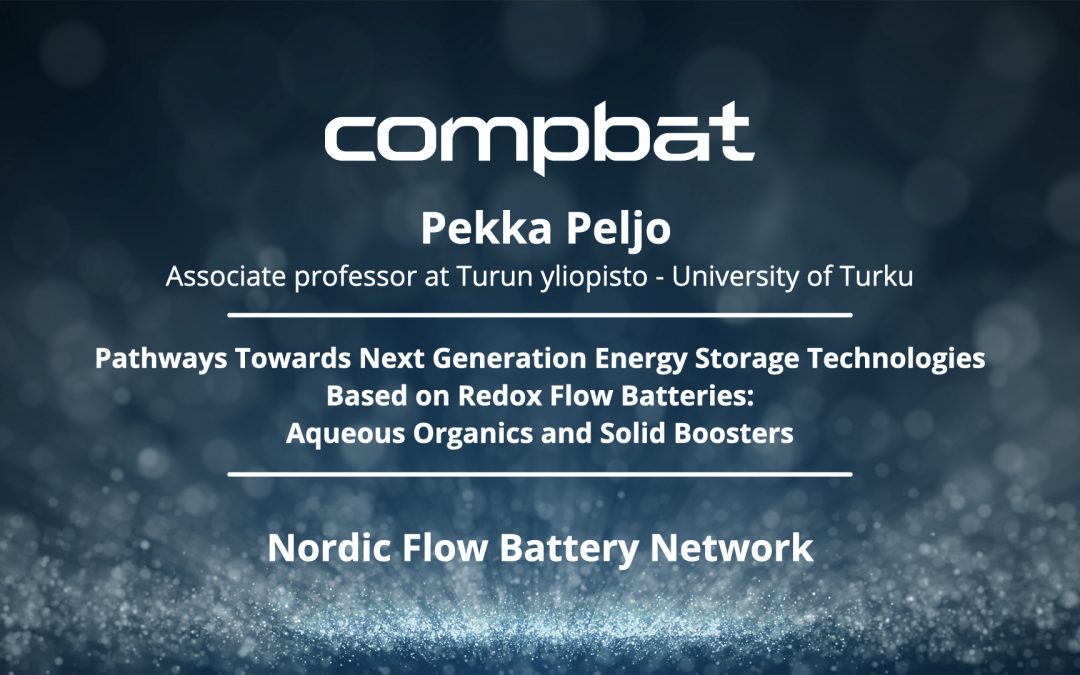Pathways Towards Next Generation Energy Storage Technologies Based on Redox Flow Batteries: Aqueous Organics and Solid Boosters
On Monday the 22nd of February, Prof Pekka Peljo is going to give a presentation in the Nordic Flow Battery Network monthly seminar.
Anyone interested can follow the presentation by clicking on this link.
Redox flow batteries offer interesting options for electrochemical energy storage and also for heat-to power conversion. In the first part of the talk, we will discuss the possibilities offered by organic redox couples in aqueous solutions [1], report some recent examples from our lab, and describe our collaborative efforts for the computational screening of organic redox couples within CompBat H2020-project.
In the second part of the talk, we shall introduce the concept of solid boosters for flow batteries. The advantage of such systems is that they allow relaxing the requirement for high solubility of the redox couple, therefore significantly increasing the number of redox couples available for flow batteries. Wang et al. in 2013 [2] first suggested this concept, where the electrolyte tank is filled with solid redox-active mm-sized beads forming a backed-bed type system.
Firstly, the redox mediator is charged in the electrochemical cell and pumped back into the storage tank. The charge is then transferred into the solid material in a chemical reaction with the mediator, similarly to “molecular wiring” used, for example, in electrochemical enzymatic glucose sensors [3]. The redox mediator can then be further charged in the electrochemical cell. We and others have shown that, if the redox potentials of the solid and soluble materials match well enough, a significant amount of the charge storage capacity of the solid materials can be used with a single mediator. [4-7] Since charge storage density is much higher in solids, a lower concentration of the mediators can be used, given that the capacity of the flow battery boosted with solids is mostly due to the solid only.
1 Gentil S.; Reynard D.; Girault HH. Aqueous organic and redox-mediated redox flow batteries: a review. Curr Opinion Electrochem 2020, 21 7. https://doi.org/10.1016/j.coelec.2019.12.006
2 Huang, Q.; Li, H.; Grätzel, M.; Wang, Q. Reversible chemical delithiation/lithiation of LiFePO4: towards a redox flow lithium-ion battery, Phys. Chem. Chem. Phys., 2013, 15 1793. DOI:10.1039/C2CP44466F
3 Heller, A.; Feldman, B. Electrochemical Glucose Sensors and Their Applications in Diabetes Management, Chem. Rev. 2008, 108, 2482-2505. DOI: 10.1021/cr068069y
4 Zanzola, E.; Dennison, C. R.; Battistel, A.; Peljo, P.; Vrubel, H.; Amstutz, V.; Girault, H. H. Redox Solid Energy Boosters for Flow Batteries: Polyaniline as a Case Study. Electrochim. Acta 2017, 235 664–671. DOI: 10.1016/j.electacta.2017.03.084
5 Zanzola, E.; Gentil, S.; Gschwend, G.; Reynard, D.; Smirnov, E.; Dennison, C.R.; Girault, H.H.; Peljo, P., Solid electrochemical energy storage material for aqueous redox flow batteries: the case of copper hexacyanoferrate, Electrochimica Acta, 2019, 321, 134704. DOI: 10.1016/j.electacta.2019.134704
6 Yu, J.; Fan, L.; Yan, R.; Zhou, M.; Wang, Q. Redox Targeting-Based Aqueous Redox Flow Lithium Battery. ACS Energy Lett. 2018, 3 (10), 2314–2320. DOI: https://doi.org/10.1021/acsenergylett.8b01420
7 Ye, J.; Xia, L.; Wu, C.; Ding, M.; Jia, C.; Wang, Q. Redox Targeting-Based Flow Batteries. J. Phys. D. Appl. Phys. 2019, 52 (44), 443001. DOI: https://doi.org/10.1088/1361-6463/ab3251
